About
The Biosensors for bioengineering group is a senior group under ICREA’s Tenure Track scheme.
Organs-on-a-chip (OOC) refers to a technology that involves creating microscale devices that mimic the structure and function of human organs. These “chips” are typically composed of living cells arranged on a microfluidic platform, allowing researchers to simulate the complex interactions and physiological responses within a specific organ.
The goal of Organs-on-a-chip (OOC) technology is to provide a more accurate and representative model of human organs compared to traditional in vitro cell cultures or animal testing. By replicating the microenvironment of organs and incorporating various cell types, organs-on-a-chip can help researchers study the effects of drugs, toxins, and diseases in a more realistic and controlled manner.
Each organ-on-a-chip device is designed to replicate the unique characteristics of a particular organ, such as the liver, pancreas or skeletal muscle. These miniature systems enable researchers to observe and analyze how different substances and conditions affect cellular behavior, tissue function, and overall organ responses. The technology holds promise for drug development, disease modeling, and toxicology studies, offering a more ethical and efficient alternative to traditional methods.
Our research on OOC development has clear goals. We want OOC platforms to be easy to use and more automation to set up cell cultures. This will help more people use them, making experiments quicker and more reliable.
We’re working on creating a simple platform for growing microtissues in 3D. This makes OOC research easier to use in the real world, moving from lab tests to practical applications. We also want to improve the user experience by making OOC platforms more friendly, compatible, and ready for use.
As OOC research moves from labs to real-world use, we want to help users deal with biological challenges. We’re developing an easy-to-use 3D tissue platform and a simple bioreactor that works with sensing technology. This helps users focus on solving biological problems, validating models, and finding potential medicines. We’re also adding sensors to make the bioreactor even more effective.
Our efforts make it easier for researchers to study how organs interact. Our second goal focuses on studying more complex disease models. This helps us understand diseases better and find ways to treat them. We believe that OOCs help in three main ways: understanding diseases, making better medicines faster, and supporting personalized research using cells from individual patients. OOCs can be a solution for studying rare diseases where other methods are not available.
Our third goal is to standardize OOC platforms, making them work together better. This involves creating common rules and standards for everyone to follow. This makes collaboration and sharing information easier.
Finally, our lab is working towards making OOCs suitable for high-throughput screening. This means making them simpler and adding good models for studying diseases. In short, we’re making OOC development more user-friendly, accessible, and technologically advanced. This simplification helps in biological research and finding new medical solutions.
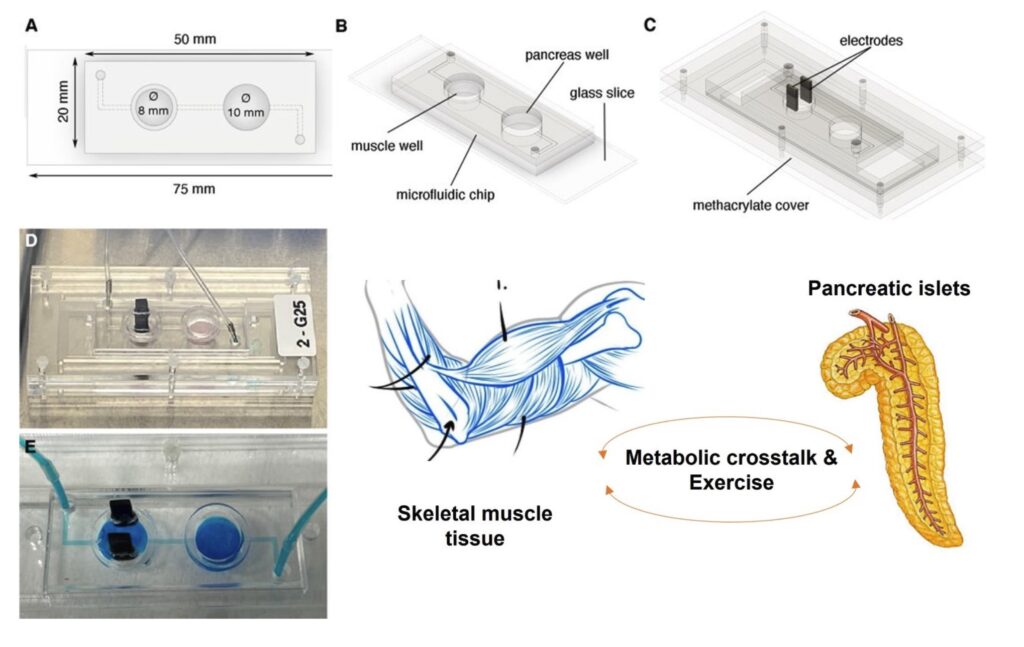
Staff
Javier Ramón Azcón
Projects
| NATIONAL PROJECTS | FINANCER | PI |
|---|---|---|
| Development of a “Muscle-on-a-Chip” (MoC) platform for the preclinical evaluation of potential therapies for Duchenne muscular dystrophy (2020-2022) | DUCHENNE ESPAÑA, IV Convocatoria Ayudas a Proyectos de Investigación | Juanma Fernandez |
| BLAD · BioLiver Assist Device (2020-2021) | AGAUR, Ajuts per a projectes innovadors amb potencial d’incorporació al sector productiu – LLAVOR | Javier Ramón |
| INNOTEC- Javier Ramon- Naturfiltr (2021-2023) | TECNIO | Javier Ramón |
| ASITOC Atomic-Sensor-Integrated Tissue-On-a-Chip: optically detected biomagnetism to understand muscular diseases (2021-2022) | BIST_Barcelona Institute of Science and Technology | Juanma Fernandez |
| INTERNATIONAL PROJECTS | FINANCER | PI |
|---|---|---|
| DAMOC · ‘Diabetes Approach by Multi-Organ-on-a-Chip’ (2017-2022) | ERC | Javier Ramón |
| BLOC · Benchtop NMR for Lab-on-Chip (2020-2022) | European Comission FET-Open | Javier Ramón |
| PRIVATELY FUNDED PROJECTS | FINANCER | PI |
|---|---|---|
| Tatami · Therapeutic targeting of MBNL microRNAs as innovative treatments for myotonic dystrophy (2019-2022) | Fundació bancaria “La Caixa” | Javier Ramón |
| FINISHED PROJECTS | FINANCER | PI |
|---|---|---|
| Programa Faster Future 2020: COVID-19 (2021) | Fundraising | Javier Ramón |
| INDUCT · Fabrication of a biomimetic in vitro model of the intestinal tube muscle wall: smooth muscle-on-a-chip (2018-2020) | MINECO | Javier Ramón |
Publications
(See full publication list in ORCID)
[br]
Equipment
Micro and nanofabrication techniques:
- 3D microstructures on hydrogel materials
- Mini-bioreactor for 3D cell culture
- Microelectrodes fabrication
- Synthesis and chemical modification of polymers and surfaces
- Dielectrophoretic cells and micro particles manipulation
Characterization techniques:
- Optical Microscopes (white light/epifluorescence)
- Electrochemical techniques (Potentiometric/Amperometric/Impedance spectroscopy)
- Immunosensing techniques (Fluorescence ELISA/Colorimetric ELISA/magneto ELISA)
Equipment:
- Microfluidic systems (High precision syringe pumps/Peristaltic pumps/Micro valves)
- Biological safety cabinet (class II)
- Epifluorescence microscope for live-cell imaging
- Pulsar – a high-resolution, 60MHz benchtop NMR spectrometer from Oxford Instruments
Access to the Nanotechnology Platform (IBEC Core Facilities): equipment for hot embossing lithography, polymer processing and photolithography, chemical wet etching, e-beam evaporation and surface characterization (TOF-SIMS)
Access to the Scientific and Technological Centers (University of Barcelona): equipment for surface analysis (XPS, AFM, XRD), organic structures characterization (NMR) and microscopy techniques (SEM, TEM, confocal)
Collaborations
We collaborated closely with Professor Ruben Artero from Instituto de Investigaciones Clínicas de Valencia (INCLIVA) and medical doctor Vilchez from Hospital de la Fe (Valencia). We develop muscle-on-a-chip devices using 3D tissue cultures and biosensors. During my career, I established national and international collaborations with other researchers, clinicians, and companies. This is reflected by the fact that I attracted competitive funding awarded by the prestigious entity Medical Research Council (UK), focused on studying Duchenne’s rare disease. I also collaborate on projects with more clinical groups and hospitals, e.g., Hospital de Sant Pau (Barcelona). With senior professor Eduard Gallardo’s group, we are developing human microtissues to study the myasthenia gravis neuromuscular rare disease.
Following the translational nature of my research, I recently became the entrepreneurial scientist of a valorisation project financed by Producte Call (AGAUR) to bring to the market plasmonic biosensors for Myasthenia Gravis diagnosis. I actively collaborate with patient associations such as “Duchenne Parent Project ” and “Asociación Conquistando Escalones,” and with national and international companies such as Arthex biotech, SOM biotech, BI/OND (The Netherlands), and BioEmTech (Greece). I have also established contacts with the industry to develop new technology with a high impact on clinical diagnosis and drug development. Specifically, we collaborate with Grifols (Spain), Multivawe (Switzerland), Oxford Instrument (UK) and NovoNordisk (Denmark). This last collaboration aims to develop new biomaterials for cell therapies. I have also established contacts with the industry to develop new technology with a high impact on clinical diagnosis and drug development, specifically collaborating with Multiwave (Switzerland) and Oxford Instrument (United Kingdom). I am also co-founder of a spin-off company, Vitala.
News

IBEC participates in Innovation Day Barcelona 2020
From 31st October until 7th November participants from different fields and nationalities participated in the 3rd edition of the Innovation Day (i-Day), a series of events organised by EIT Health in partnership with local research and health institutions.
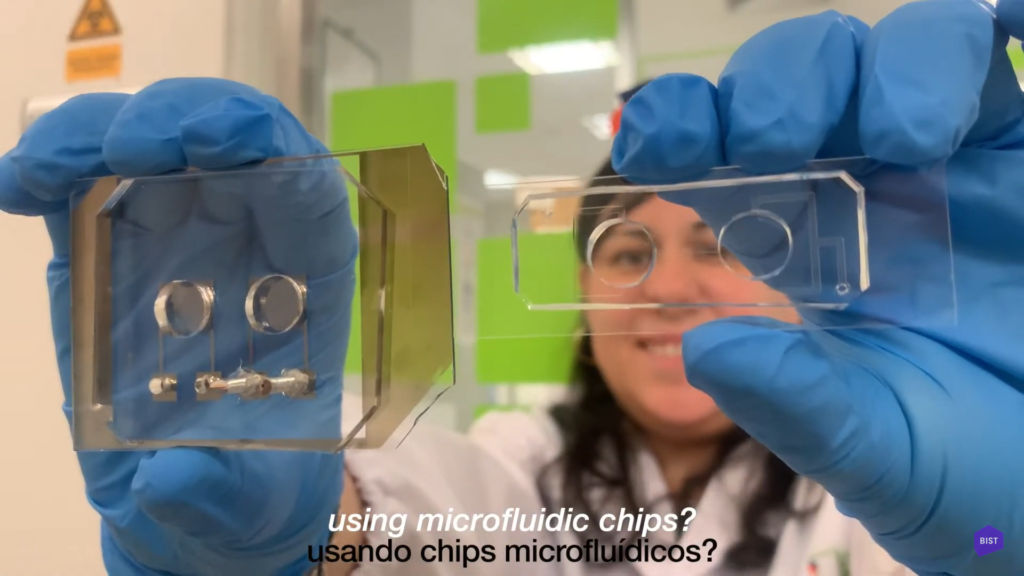
IBEC researchers awarded for their communication activities
Several researchers from IBEC have been awarded for their quality in spreading the word of bioengineering. From scientific talks, to videos and posters, IBEC scientists and engineers show their talent inside, but also, outside the lab.
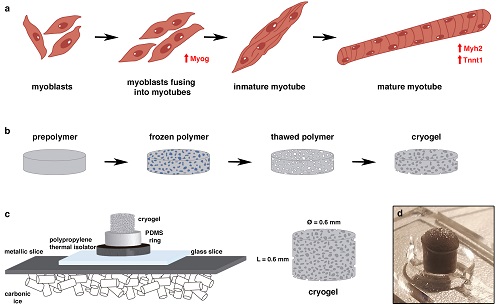
Nanotechnology to improve human tissue growth in the laboratory
Researchers from the Institute for Bioengineering of Catalonia (IBEC) have developed an innovative scaffold that allows muscle tissues growth at the millimetre scale in the laboratory. This technology opens the door to potential applications in fields such as organ transplantation and engineering, drug screening and disease modelling.
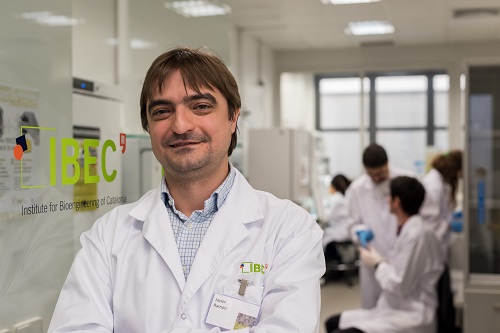
Javier Ramón, new ICREA professor at IBEC
Javier Ramón, Group Leader of the “Biosensors for Bioengineering” group at IBEC, has been appointed new Research Professor at the Catalan Institution for Research and Advanced Studies, ICREA. Currently IBEC hosts 8 ICREA Professors out of 22 group leaders. Since last April 1, Dr. Javier Ramón, Group Leader at IBEC, has become part of the ICREA Research Professors community. ICREA is a foundation funded by the Catalan Government aimed at recruiting the most extraordinary and talented international scientific researchers. With this appointment, IBEC hosts 8 ICREA Professors and 2 ICREA Academia (UB affiliated professors), one of the highest numbers among all research centres in Catalonia.
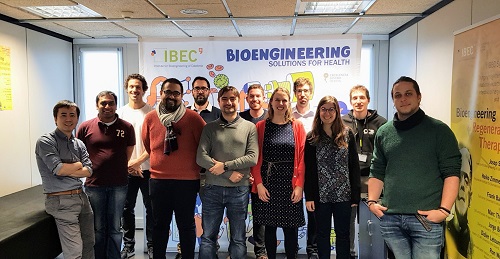
IBEC leads a European Project to evaluate drug response in organ-on-a-chip devices
A group of researchers from the Institute for Bioengineering of Catalonia (IBEC) leads the European project BLOC, an initiative led by researchers Javier Ramón and Irene Marco that seeks to evaluate the response to different drugs in metabolic diseases using organ-in-a- chip by using nuclear magnetic resonance (NMR). For this, the consortium will have a budget of almost 3 million euros, financed by the Horizon 2020 FET Open program.
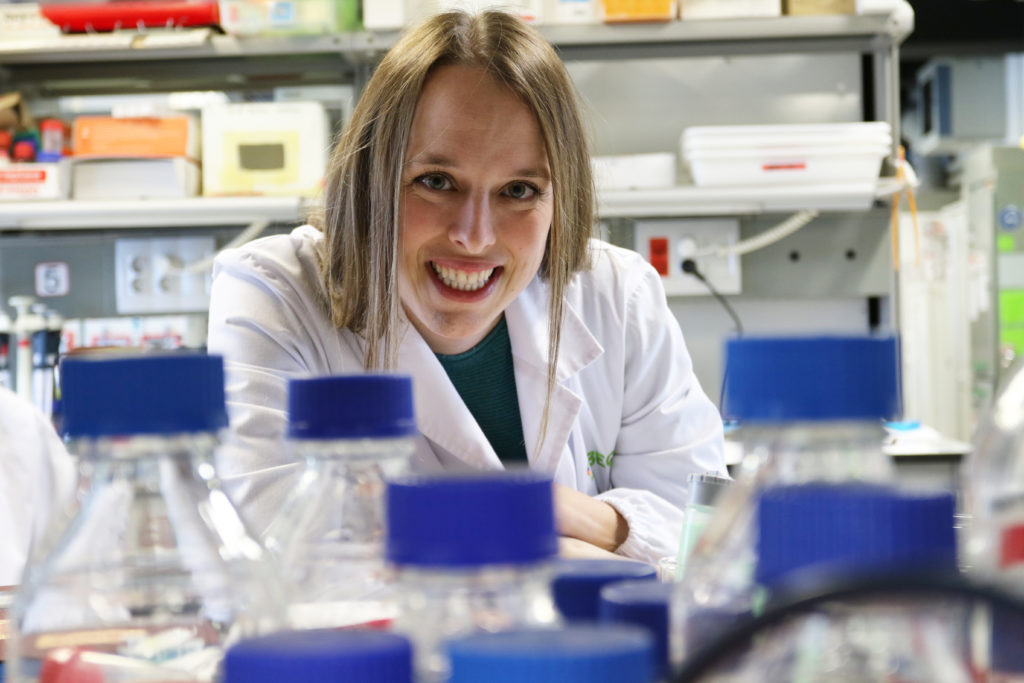
How to choose the best drug for each cancer patient? Irene Marco featured at BigVan La Vanguardia
Irene Marco explains at BigVan, the scientific section of La Vanguardia journal, how thanks to microfluidics and research based on the use of “organ-on-a-chip” devices, we can go a step forward towards personalized medicine.

IBEC presents its capabilities in 3D bioprinting and in other industrial areas at the fourth INDUSTRY edition
During the 29th to 31st of October, IBEC participated in the fourth edition of “INDUSTRY: From Needs to Solutions”, the international meeting dedicated to 3D printing, and also the HELTHIO Days where Josep Samitier moderated the round table on 3D printing applications in healthcare. In its fourth edition, IN(3D)USTRY becomes INDUSTRY to include more industrial sectors, the main goal is to cover the entire value chain and provide intelligent manufacturing solutions. The institute had a stand in the exhibition area, where the representatives of the IBEC Technology Transfer office welcomed the interested visitors to learn more about the 3D bioprinting capabilities of IBEC.
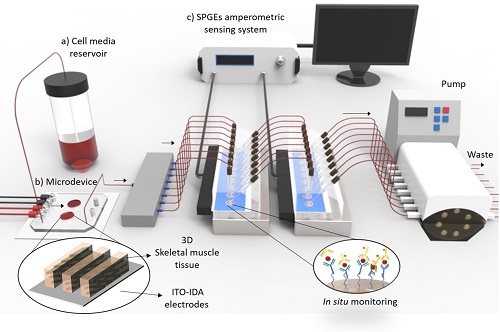
Researchers at IBEC develop a bioengineering platform to detect pro-inflammatory molecules in muscular disorders
The Biosensors for bioengineering group led by Javier Ramón has developed a sensing platform for the in-situ detection of tissue-secreted pro-inflammatory molecules, the so-called cytokines. This new methodology opens a new door in the understanding of metabolic-disorders such those found in muscular diseases, as well as the development of drug-screening applications. Although 40% of total body mass is skeletal muscle tissue, there is no specialized clinical doctor for the treatment of muscular diseases, according to the American Medical Association. The research group of Dr. Javier Ramón at IBEC works to fill this gap between muscle disorders and ad hoc therapies.
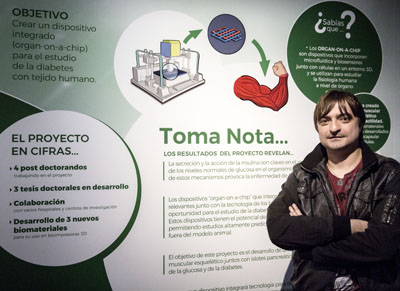
IBEC researcher’s ERC project highlighted in Madrid exhibition
This weekend Javier Ramon’s European Research Council-funded project, DAMOC, was one of eight highlighted in a special exhibition in Madrid to mark the ERC’s tenth anniversary. Alcobendas’ Museo Nacional de Ciencia y Tecnología (MUNCYT) displayed the most “outstanding” projects led by researchers in Spain as part of a full weekend of activities to celebrate the first decade of the prestigious funding body, which was launched in 2007 by the European Union and has funded nearly 7,000 researchers, among them six Nobel Prize winners.
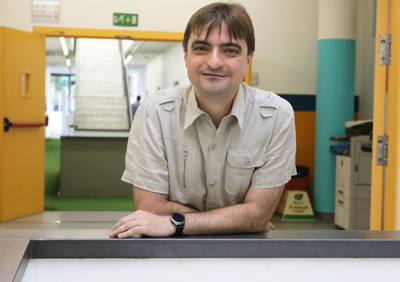
ERC funding for new diabetes approach at IBEC
IBEC’s Dr. Javier Ramón is one of just six researchers in Catalonia to have been awarded a 2016 Starting Grant by the European Research Council (ERC). The senior researcher in the Biomimetic Systems for Cell Engineering group won funding for his project ‘Diabetes Approach by Multi-Organ-on-a-Chip’ (DAMOC) from Europe’s most prestigious funding body. With the support, which will last for up to five years, Javier will start a new line to design a innovative new tool to test drugs for diabetes. As well as improving drug testing approaches, the multi-organ-on-a-chip device will provide new therapies to prevent the loss of beta cell mass and defects in the glucose uptake in skeletal muscle associated with type 2 diabetes. “This project will give me the opportunity to have a multidisciplinary group of researchers working together from the beginning in a synchronized way, the most rewarding experience that a researcher can have,” he says.


 ibecbarcelona.eu
ibecbarcelona.eu